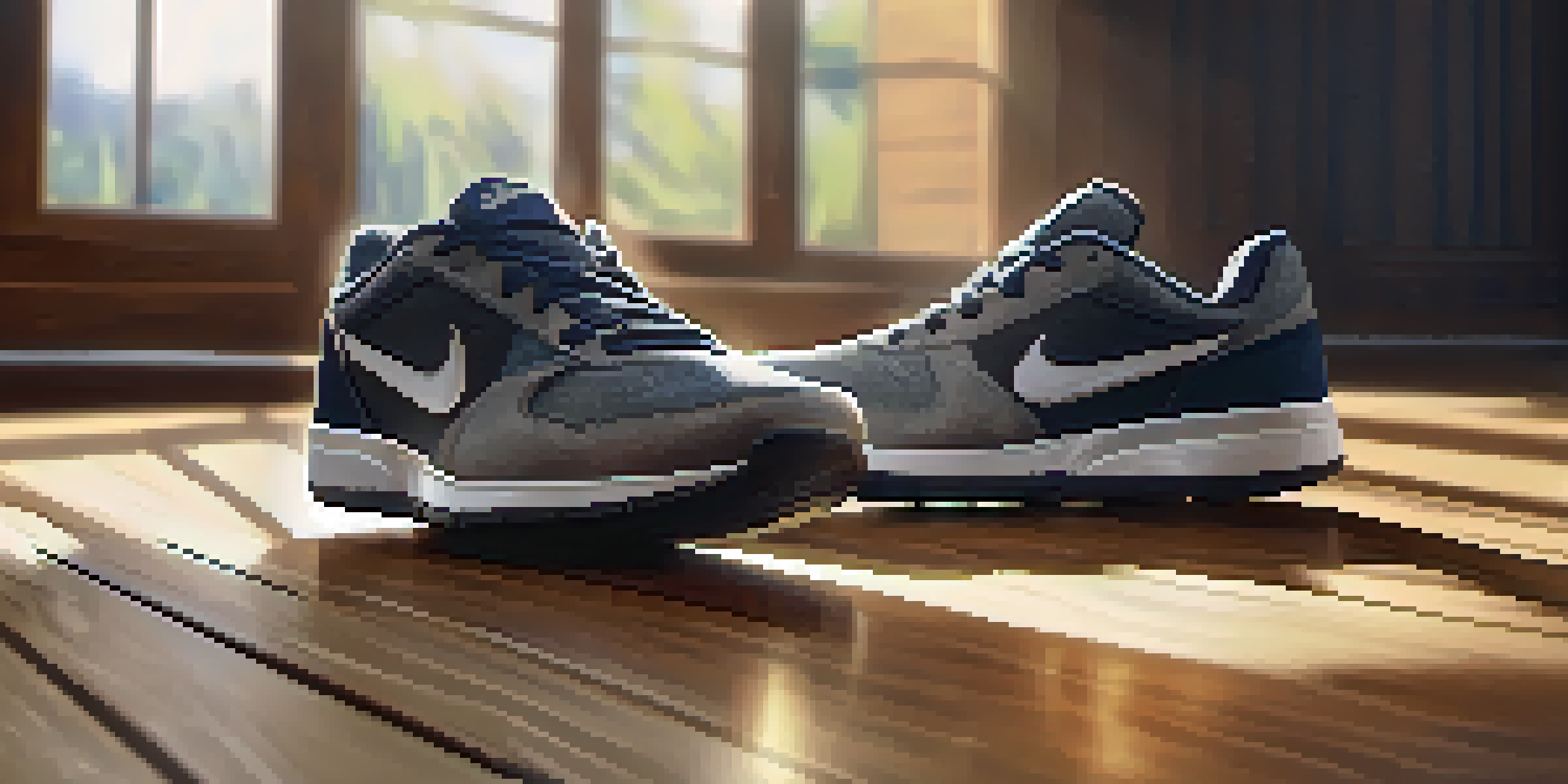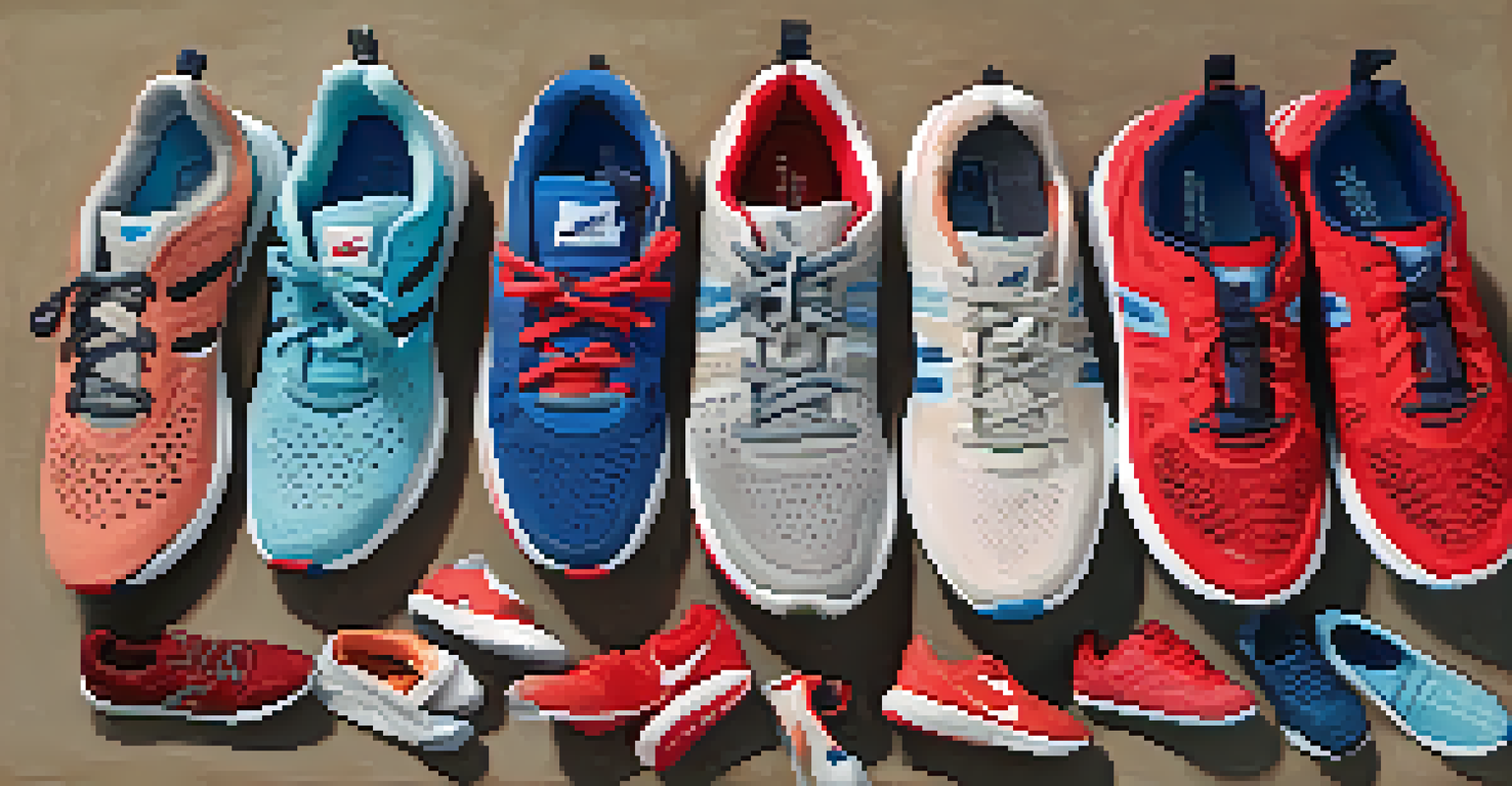How to Choose the Right Footwear for Injury Prevention in Training

Understanding the Importance of Proper Footwear
Proper footwear is crucial for anyone engaging in physical training. The right shoes can help absorb impact, provide support, and reduce the risk of injuries. Think of your feet as the foundation of your body; if the foundation is weak, everything built on it can falter.
The right shoes can make all the difference in your performance and comfort.
Injury prevention starts with understanding how your foot interacts with the ground. Shoes that fit well and provide adequate support can help align your body properly during workouts. This alignment is key to preventing common injuries like strains and sprains.
Moreover, the right footwear can enhance performance by allowing for better movement dynamics. Imagine running in shoes that are too tight or too loose; it can be uncomfortable and lead to injuries. Investing in the right shoes is investing in your health and performance.
Identifying Your Foot Type
Before you start shopping for shoes, it's essential to know your foot type. There are three primary types: flat, neutral, and high-arched. Each type requires different shoe characteristics to provide the best support and cushioning.

For instance, flat-footed individuals often benefit from shoes that offer stability and motion control. Conversely, those with high arches may need extra cushioning to absorb impact. Understanding your foot type can make a significant difference in comfort and injury prevention.
Choose Shoes for Your Foot Type
Understanding whether you have flat, neutral, or high-arched feet ensures you select shoes that provide the right support and comfort.
You can determine your foot type by observing your footprint or consulting a professional at a specialty shoe store. This simple step can help you avoid common mistakes and ensure you're choosing the right footwear for your training needs.
Evaluating Shoe Fit and Comfort
Fit is arguably the most critical factor when selecting training footwear. A well-fitted shoe should feel snug but not overly tight, allowing for some wiggle room for your toes. Remember, the right fit can prevent blisters and other irritations that can sideline your training.
Investing in quality footwear is investing in your health.
When trying on shoes, it's best to wear the socks you plan to use during training. Walk around the store to gauge comfort and ensure there are no pressure points. A little discomfort in the store may translate to significant pain during a workout.
Also consider the width of the shoe; some brands offer different width options. This attention to detail can make all the difference in finding a shoe that feels like an extension of your foot, reducing the likelihood of injury.
Understanding Cushioning and Support
Cushioning and support are crucial elements in footwear for injury prevention. Shoes with adequate cushioning can absorb shock and reduce the impact on your joints during training. Think of cushioning as the difference between running on a hard surface versus a soft one; the softer surface is gentler on your body.
Support, on the other hand, helps maintain proper alignment and stability. Look for shoes that offer arch support tailored to your foot type. This helps distribute weight evenly, reducing stress on specific areas of your feet and legs.
Fit and Comfort Are Key
A well-fitted shoe should feel snug yet comfortable, preventing blisters and ensuring better performance during training.
Keep in mind that too much cushioning can also be a drawback, as it may hinder your ability to feel the ground. Striking a balance between comfort and responsiveness is key to finding the right shoes for your training.
Considering the Type of Training You Do
The type of training you engage in plays a significant role in determining the right footwear. For instance, runners typically need shoes designed for forward motion, while weightlifters may benefit from shoes with a flatter sole for better stability. Each activity has its unique demands on your feet.
If you're a cross-trainer, you might want a versatile shoe that offers a mix of cushioning and support. On the other hand, if you're into sports like basketball or tennis, look for shoes with lateral support to protect against ankle injuries.
Understanding the specific needs of your training regimen can help you choose footwear that enhances your performance while minimizing injury risk. This consideration ensures your shoes are suited to the demands of your workouts.
Testing Shoes Before Purchase
Once you've narrowed down your options, testing the shoes before purchasing is essential. Many specialty stores allow customers to try shoes on a treadmill or walking track. This experience can help you assess how the shoes feel during movement, which is crucial for ensuring comfort and support.
Don't hesitate to take your time during this process. Walk, jog, or even do some light exercises to get a feel for how the shoes perform. Pay attention to any discomfort or pressure points, as these can lead to injuries down the line.
Test Shoes Before Buying
Trying on shoes during movement helps evaluate their comfort and support, reducing the risk of injury after purchase.
Additionally, consider wearing the shoes for a short period in the store to see how they feel over time. This simple test can save you from making a costly mistake and help you find the best footwear for your training.
Maintaining Your Footwear for Longevity
Once you've found the perfect pair of training shoes, it's essential to take care of them. Proper maintenance can extend the life of your footwear and continue providing the support you need. Regularly check for wear and tear, especially on the soles and cushioning.
Cleaning your shoes regularly can also help maintain their performance. Remove dirt and debris after each use and allow them to air out to prevent odors. Some materials can be washed, while others may require a more gentle approach.

Lastly, keep an eye on how your shoes feel over time. If you start to notice discomfort or reduced support, it may be time to replace them. Staying proactive about your footwear's condition can help prevent injuries and keep you training effectively.